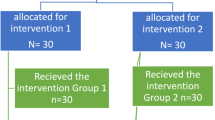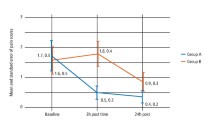Abstract
Data sources
Dental trials were sought among systematic reviews of randomised, double-blind studies of analgesics in acute pain, which were identified from the Cochrane Library, Biological Abstracts, MEDLINE, PubMed and the Oxford Pain Relief database.
Data extraction and synthesis
Data were extracted independently by two reviewers. Dichotomous information from active and placebo treatments was used, first to calculate the statistical significance using relative risk, and then to evaluate the clinical relevance using number-needed-to-treat (NNT).
Results
Nonsteroidal anti-inflammatory drugs (NSAID) and cyclooxygenase (COX)-2 inhibitors had the lowest (best) NNT for the outcome of pain at least halved over 4–6 h compared with placebo. With the best performing analgesics, 50–70 patients out of 100 had good pain relief compared with about 10 out of 100 with placebo. Only paracetamol (600/650 mg) plus codeine (60 mg) was associated with any significant increase in any patient experiencing an adverse event.
Conclusions
NSAID and COX-2 inhibitors have the lowest (best) NNT. These may also have fewer adverse effects after third molar surgery, but conclusive evidence is lacking. At least 80% of analgesic prescribing by UK dentists is in line with the best available evidence on efficacy and safety.
Similar content being viewed by others
Log in or create a free account to read this content
Gain free access to this article, as well as selected content from this journal and more on nature.com
or
References
McQuay HJ, Edwards JE, Moore RA . Evaluating analgesia: the challenges. Am J Ther 2002; 9:179–187.
Edwards JE, McQuay HJ, Moore RA, Collins SL . Reporting of adverse effects in clinical trials should be improved: lessons from acute postoperative pain. J Pain Symptom Manage 1999; 18:427–437.
Moore RA, Edwards JE, McQuay HJ . Acute pain: Individual patient meta-analysis shows the impact of different ways of analysing and presenting results. Pain 2005; 116:322–331.
Smith LA, Moore RA, McQuay HJ, Gavaghan D . Using evidence from different sources: an example using paracetamol 1000 mg plus codeine 60 mg. BMC Med Res Methodol 2001; 10:1:1.
Author information
Authors and Affiliations
Additional information
Address for correspondence: RA Moore, Research Director, Pain Research and Nuffield Department of Anaesthetics, University of Oxford, Oxford Radcliffe Hospital, The Churchill, Headington, Oxford OX3 7LJ, UK. E-mail: andrew.moore@pru.ox.ac.uk
Barden J, Edwards JE, McQuay HJ, Wiffen PJ, Moore RA. Relative efficacy of oral analgesics after third molar extraction. Br Dent J 2004; 197:407–411
Rights and permissions
About this article
Cite this article
Skoglund, L. Good evidence for effectiveness of analgesics most commonly prescribed by UK dentists. Evid Based Dent 6, 66 (2005). https://doi.org/10.1038/sj.ebd.6400337
Published:
Issue date:
DOI: https://doi.org/10.1038/sj.ebd.6400337



